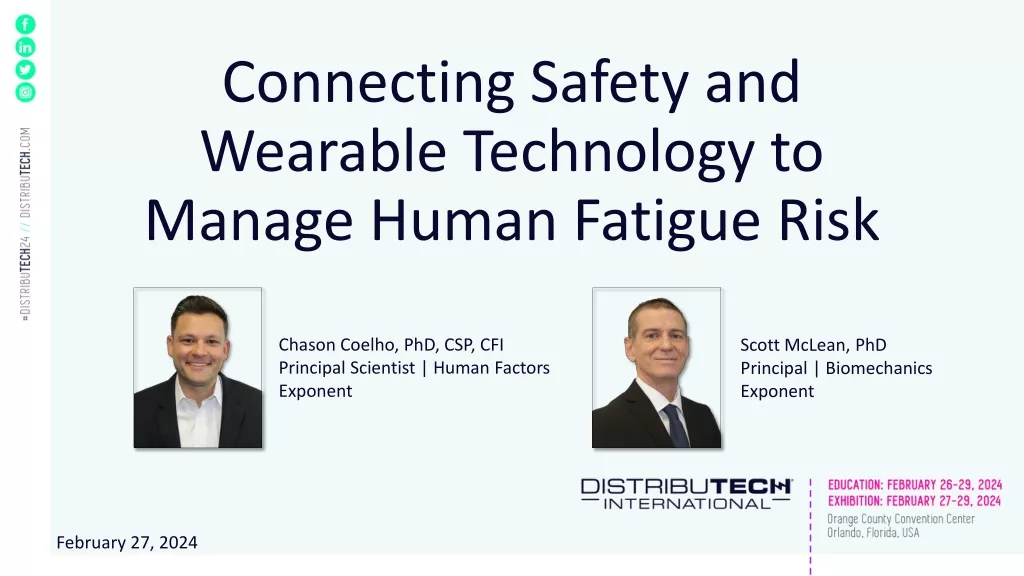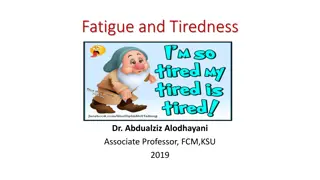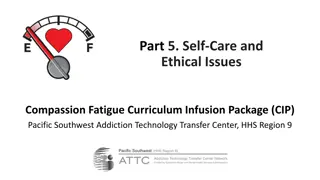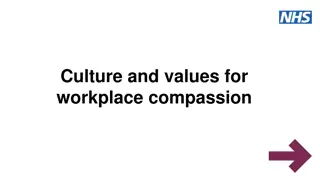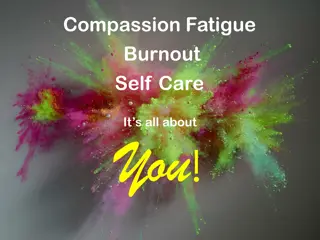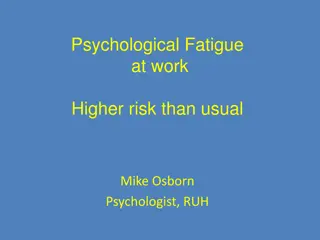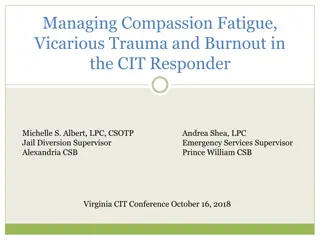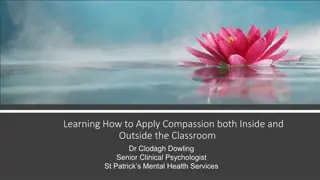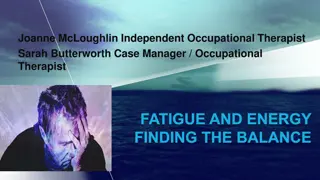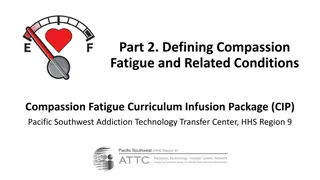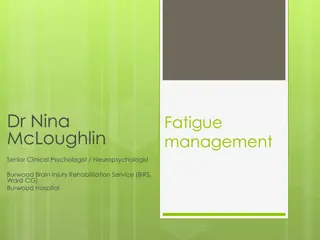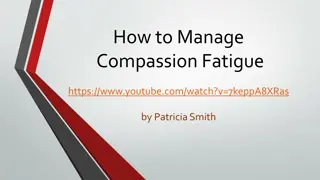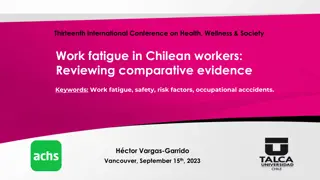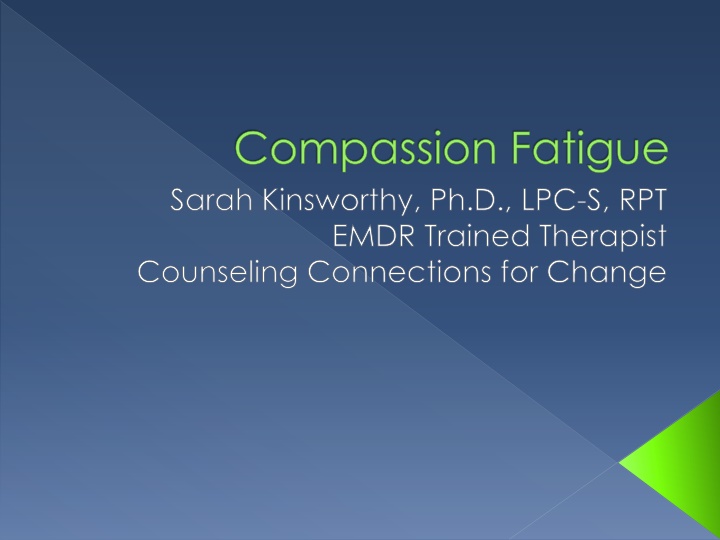
Compassion Fatigue: Risks, Prevention, and Treatment
Dive into the definitions, history, risk factors, prevention strategies, and treatment options for compassion fatigue, a common consequence of working with individuals in distress or trauma. Learn how to identify warning signs and personalize self-care to combat this stress.
Download Presentation

Please find below an Image/Link to download the presentation.
The content on the website is provided AS IS for your information and personal use only. It may not be sold, licensed, or shared on other websites without obtaining consent from the author. If you encounter any issues during the download, it is possible that the publisher has removed the file from their server.
You are allowed to download the files provided on this website for personal or commercial use, subject to the condition that they are used lawfully. All files are the property of their respective owners.
The content on the website is provided AS IS for your information and personal use only. It may not be sold, licensed, or shared on other websites without obtaining consent from the author.
E N D
Presentation Transcript
Compassion Fatigue Sarah Kinsworthy, Ph.D., LPC-S, RPT EMDR Trained Therapist Counseling Connections for Change
Presentation Outline 1. Definitions What is Compassion Fatigue? Other associated terms 2. Brief History 3. Risk Factors Who is at risk? What increases risk of Compassion Fatigue? Assessment 4. Prevention Learn the warning signs 5. Compassion Fatigue Tool Kit Identification of personalized self-care needs 6. Treatment
Define: Fatigue Mental or physical exhaustion Extreme tiredness or weariness resulting from physical or mental activity Weak with fatigue after a long run Inability to respond to a situation The temporary inability of an individual to respond to a situation as a result of overexposure or excessive activity Compassion fatigue Physiologically unable to respond to stimulus The temporary inability of an organ or body part such as muscle to respond to a stimulus and respond normally after continuous activity or stimulation (Merriam Webster, 2017)
Other Important Definitions Compassion sympathetic consciousness of others' distress together with a desire to alleviate it Suffering the state or experience of one that suffers pain Trauma an injury (such as a wound) to living tissue caused by an extrinsic agent a disordered psychic or behavioral state resulting from severe mental or emotional stress or physical injury an emotional upset (Merriam Webster, 2017)
What is Compassion Fatigue? Described as the natural, predictable, treatable and preventable unwanted consequence of working with suffering people, that is, the cost of caring. (Figley, 1995) A type of stress that results from others that are experiencing significant stress, duress, suffering, or trauma. Helping other people or animals
Compassion Fatigue Also known as: Second-hand shock Secondary traumatic stress (Stemm, 1995, 1997) Secondary victimization (Figley, 1982) Vicarious trauma (Perlman & Saakvitne, 1995) The label of Compassion Fatigue is perceived to be less stigmatizing than the aforementioned terms Compassion Fatigue is different than burnout
Compassion Fatigue Compassion Fatigue (CF) can lead to burnout. CF is the preoccupation with trauma and emotional stresses of others. It portrays symptoms similar to burnout, but is not actually burnout. The onset of CF is faster and there is a better opportunity to recover. (Endicott, 2006)
A syndrome of symptoms nearly identical to PTS(D), except that exposure to a traumatizing event experienced by one person becomes a traumatizing event for the second person. (Figley, 1999, p. 11)
Compassion Fatigue History After the Vietnam war Began identifying veterans with Posttraumatic Stress Disorder (PTSD) in 1970 s Officially added to the DSM-III in 1980 Prior to the term PTSD, the veterans with traumatic reactions were referred to as having: Shell Shock (WWI) Battle Fatigue or Combat Stress Reaction (WWII) In 1952, Gross Stress Reaction (DSM-I) (U.S. Department of Veterans Affairs, 2017) Clinicians treating veterans found themselves with secondary traumatic stress disorder or compassion fatigue Charles Figley, is well known for his research on CF as well as Patricia Smith, with the Compassion Fatigue Awareness Project.
Compassion Satisfaction The gratification of working in a helping profession makes our time feel worthwhile. Social workers and police officers, for example, will often continue in their jobs after physical and/or psychological injury, and find themselves reluctant to leave the job, despite stress. This phenomenon is being satisfied with doing the work of caring (Stamm, 2002, p. 110).
Stress Stress is defined as a meaningful and essential life force or stressor that places an internal or external demand on an organism to undergo change and readjust itself. (Thoits, 1994)
Symptoms of Compassion Fatigue Emotional Indicators: anger, sadness, prolonged grief, anxiety, depression, excessive blaming, bottled up emotions, difficulty concentrating, denial that a problem exists Physical Indicators: headaches, stomach aches, lethargy, sleep problems, recurrent colds
Symptoms of Compassion Fatigue Personal Indicators: self-isolation, cynicism, mood swings, irritability with spouse/family, problems with addictions (drugs, alcohol, sex, etc.) Work Indicators: avoidance of certain clients, missed appointments, receives increased complaints from others, tardiness, and loss of motivation, voices excessive complaints about administrative functions. (Endicott, 2006)
Symptoms of Compassion Fatigue Difficulty managing emotions Difficulty making good decisions Problems managing boundaries Problems in relationships Physical problems such as aches and pains Loss of meaning/hope (Pearlman & McKay, 2008)
Compassion Fatigue Trajectory Zealot Phase Enthusiastic, committed, puts in extra hours Irritability Phase Sarcasm, cutting corners, avoiding patients, daydreaming Withdrawal Phase Neglect of family, self, clients, etc., clients become irritants, exhaustion Zombie Phase Lack compassion, little patience, auto-pilot, disdain for patients Pathology and Victimization vs. Renewal and Maturation Frequently sick, overwhelmed, burned out, or Resilience and transformation (Spilman, 2010) 1. 2. 3. 4. 5.
Challenges for Helping Professionals The skill of empathy can provide the essential bridge to helping patients or clients. The helper/provider bears a cost for caring and practicing empathy.
Moral Stress Have you ever found yourself in a situation where your efforts to do what is right are thwarted? Do you experience frustration or uncertainty due to barriers to care? Asked to increase case loads, take fewer breaks, increase paperwork? Inability to follow best practices due to work constraints?
Highly treatable Sudden onset Symptom of other stressors Compassion Fatigue versus Compassion Fatigue Burnout Mental or physical collapse caused by overwork or stress Can be more challenging to treat Happens over time Individuals may need to change occupation or jobs in serious cases Emotional exhaustion Diminished caring or cynicism Burnout
Burnout Burnout, on the other hand, is subtle, and over time, leads one to believe that he/she is not meant for this type of work. Feelings include those of being ineffective, callous, negative, emotionally absent, sarcastic and stuck. When one reaches this career point, interest in staying with the job diminishes. (Endicott, 2006)
Burnout Exhaustion: A state of physical, emotional and mental exhaustion caused by long term involvement in emotionally demanding situations. (Pines & Aronson) Disillusionment: A state of fatigue or frustration brought about by devotion to a cause, way of life, or relationship that failed to produce the expected reward. (Freudenberger)
Burnout Soul Erosion: The index of the dislocation between what people are and what they have to do. It represents an erosion in values, dignity, spirit and will an erosion of the human soul. It is a malady that spreads gradually and continuously over time, putting people into a downward spiral (Maslach & Leiter). (Endicott, 2006)
The Cost of Caring Loss of morale Reduced job performance Increased sick leave Interpersonal relationships suffer Deterioration of health Irritability and blame Shaken belief system Out-of-control (Endicott, 2006)
Who is at Risk? Affects individuals in helping professions and caregivers. Any individual working in a helping or healing capacity. Medical personnel, therapists, first responders, insurance adjusters, attorneys, teachers, etc.
Who is at an INCREASED Risk? Those that specialize in therapy that exposes them to extreme issues most sessions. Being physically threatened by someone under our care. Someone under our care dying by suicide. Providing care to individuals that are considered dangerous. Working with individuals that experience depression.
Who is at an INCREASED Risk? Working with those that have experienced child abuse. Those that specialize in treatment for the dying, or those with grief and loss related issues. Providing services to those who have experienced the loss of a child or who have a terminally ill child.
Statistics on Professional Burnout The professional life expectancy for social workers is 8 years, according to one study in the UK. (Kinman & Grant, 2013) The Archives of Internal Medicine (2015) reported that 46% of all physicians surveyed identified as having burnout In 2013 the number was around 40% Researchers found that for each additional patient assigned to a nurse, the burnout rate increased by 23% (Aiken, Clarke, et al., 2002)
Statistics on Compassion Fatigue The National Child Traumatic Stress Network cites the development of CF is recognized as a common occupational hazard for professionals working with traumatized children. Studies show that from 6% to 26% of therapists working with traumatized populations exhibit CF. Up to 50% of child welfare workers, are at high risk of CF or the related conditions of PTSD. (NCTSN, 2017)
All of us who attempt to heal the wounds of others will ourselves be wounded, it is, after all, inherent in the relationship. (Figley, 2002)
Ethical Considerations For helping professionals, typically ethical codes require that we seek help when experiencing impairment Increased stress Death of a loved one Divorce Addictions Burnout
Ethical Considerations National Association of Social Workers 4.05 Impairment (a) Social workers should not allow their own personal problems, psychosocial distress, legal problems, substance abuse, or mental health difficulties to interfere with their professional judgment and performance or to jeopardize the best interests of people for whom they have a professional responsibility. (b) Social workers whose personal problems, psychosocial distress, legal problems, substance abuse, or mental health difficulties interfere with their professional judgment and performance should immediately seek consultation and take appropriate remedial action by seeking professional help, making adjustments in workload, terminating practice, or taking any other steps necessary to protect clients and others. (NASW, 2006) American Counseling Association C.2.g. Impairment Counselors monitor themselves for signs of impairment from their own physical, mental, or emotional problems and refrain from offering or providing professional services when impaired. They seek assistance for problems that reach the level of professional impairment, and, if necessary, they limit, suspend, or terminate their professional responsibilities until it is determined that they may safely resume their work. Counselors assist colleagues or supervisors in recognizing their own professional impairment and provide consultation and assistance when warranted with colleagues or supervisors showing signs of impairment and intervene as appropriate to prevent imminent harm to clients. (ACA, 2014)
Ethical Considerations If a helping professional is experiencing compassion fatigue or burnout, it may be time to seek help. When others are distressed or experiencing trauma, and we have our own unmanaged stress, we may be unable to help effectively.
Self Check-In If you were asked to scale your level of compassion on a scale from 0 to 10 10 being the worst you have ever felt in regards to your compassion/work/fatigue 0 being the best you ve ever felt How would you rate yourself currently?
Self Check-In For each of us, this scale may look different For some, a 7 or 8 on the scale may mean they begin to notice they are calling in sick more, or are avoiding friends For others, a 7 or 8 may mean increased conflicts at home Try to identify what your symptoms are for each number on the scale Depending on where you fall on the scale, it can indicate the necessary level of self-care currently needed.
Assessments ProQOL 5 Professional Quality of Life Scale http://www.proqol.org/ProQol_Test.html Life Stress Test http://www.compassionfatigue.org/pages/lif estress.html Empath Test http://www.tarameyerrobson.com/empath- test/
Available in 21 languages PROFESSIONAL QUALITY OF LIFE SCALE (PROQOL)
Prevention Being self-aware and practicing self- monitoring Collaborate and seek support with supervisors and mentors to help spot compassion fatigue Train staff to identify compassion fatigue
Prevention: Strategies for Self-care Physical Strategies: sleep, nutrition, exercise, massage, body scanning for tension, diaphragmatic breathing Psychological Strategies: life balance, relaxation, contact with nature, creative expression, self-awareness, spiritual practice, skill development, humor, practicing self-compassion (http://self- compassion.org/category/exercises/)
Prevention: Strategies for Self-care Social/Interpersonal Strategies: social supports, asking for help, getting help, social activism Personal/Professional Strategies: finding balance, boundaries, limit setting, saying no , conflict resolution skills, know your limits and threshold, take vacations, reduce workload when possible
Compassion Fatigue Toolkit Warning signs On the Compassion Scale 0-10, how would I scale myself (10 being worst) Schedule a weekly check-in with yourself Ask, How am I doing? What do I have control over? What can I say no to? What is not in my control? (Mathieu, 2007)
Compassion Fatigue Toolkit Know which strategies work for you Stress reduction: Do you relieve stress by working out, quality time with friends, etc? What am I able to cut back on? Stress resilience: what relaxation methods work for you? Diaphragmatic breathing, scanning the body for tension, meditation, prayer, etc. (Mathieu, 2007)
Compassion Fatigue Toolkit Remind yourself of why you became a helping professional. What is your personal creed Recall the contributions you have made and the good you have done for others Find other helping professionals in your field that you can talk to (Barnes Jewish Hospital) Compartmentalize Visualize leaving all of your worries/work stress in a box at work
Compassion Fatigue Toolkit Pearlman & McKay (2008) recommend escape, rest, and play to be primary parts of the CF toolkit Escape: reading a book, watching a movie, taking a vacation, taking the week off from work Rest: doing things to relax that have no timeline (e.g., watching the clouds, taking a nap) Play: sharing humorous stories, being creative, spending time with a child in play
Modeling to Children How do we teach the next generation self-care? Modeling self-care Placing little value on the culture of busy- ness Diminish the value of awards like Perfect Attendance Turn off the outside world and set boundaries with your time
Treatment Education on CF and its effects Talking about issues with a trusted professional Committing to regular self-care such as: exercise, healthy eating habits, getting enough quality sleep, doing hobbies Developing positive coping strategies Connecting with support groups and other networks
Resources American Counseling Association (ACA) https://www.counseling.org/docs/trauma-disaster/fact-sheet-9--- vicarious-trauma.pdf?sfvrsn=2 Compassion Fatigue Awareness Project http://www.compassionfatigue.org/ Headington Institute http://www.headington-institute.org/files/vicarious-trauma- handout_85433.pdf Mathieu, F. (2007). Running on Empty: Compassion Fatigue in Health Professionals. Rehab & Community Care Medicine. National Child Traumatic Stress Network (NCTSN) http://www.nctsn.org/resources/topics/secondary-traumatic- stress U.S. Department of Veterans Affairs https://www.ptsd.va.gov/public/PTSD-overview/basics/history-of- ptsd-vets.asp

